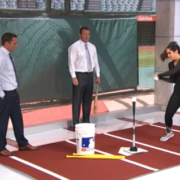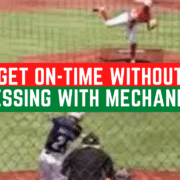Online Hitting Lessons Swing Science Program For Baseball Or Softball | Remote Instruction Coach To Teach How To Increase Bat Speed & Power
Discover an online hitting lessons swing science program for baseball and softball players. Learn where to find a remote hitting instruction coach to teach kids how to increase bat speed and power.
Batting Cages May Be Dangerous To Repeatable Power
I know you what you’re thinking, “Okay, so what’s wrong with hitting at the batting cages?”
We’ll get to that, but before we do, let me set the stage for what I’m about to share with you. A glimpse into an online hitting lesson I gave to my hitter Stephen at The Feedback Lab.
I was granted permission from Kyle (Stephen’s dad), to share his 12-year-old son’s latest online hitting session with me. They’re out of New Jersey…
What Was To Be Corrected
- Hiding his hands from the pitcher
- “Downhill” shoulder angle pre-turn, and
- Maintaining 90-degree back leg angle during turn and finish.
Stephen 2-Months Later…
In the above video, I mentioned the difference between comparing a swing off the tee versus at the batting cages. It’s not really an apples to apples comparison, BUT if they can repeat what we’re trying to get them to do off a tee, then the feeling to repeat it is there. Here’s what his analysis showed:
- Great downhill shoulder angle,
- Much better with hiding his hands from the pitcher (could polish a little here), and
- Much better body angle on his finish.
3-Points Worth Noting…
- Dad had mentioned to me, in the past 2-months, that they’ve been testing hand, butt, and hamstring tension, which might have also had an effect on Stephen’s outcomes.
- Stephen will be working on a better barrel launch angle using variance training mentioned in the above video. Pay attention to the Bat Angle Experiment I referenced in the video.
- I give feedback based on Tony LaRussa’s “Pat & Pop Method”. First give a “pat” on the back (what they did or are doing well), then reveal the “pop” (what they’ll be working to improve their swing).
Coaches, this is critical!! Athletes don’t just need to be broken down all the time. Build them up first, then offer up the constructive criticism.
The Danger in Batting Cages
And I’m not talking about Happy Gilmore style…
Someone smart once said:
“Practice like you play, so you play like you practice.”
Most coaches have their players do what’s referred to as “massed practice” versus “training ugly” at the batting cages. For example, if you needed work on hitting off speed and breaking pitches, a massed practice would look like the following scenario…a pitcher throws each hitter:
- 15 fastballs, then
- 15 curve-balls, and
- Lastly 15 change-ups…
But this isn’t what it’s like in the game. The hitter rarely knows, with 100% certainty, which pitch, speed, and location they’re getting. So practice MUST reflect this dynamic in training. And hitting at the batting cages limits the amount of variance we can work into our practice.
I do a few things with my more advanced hitters (mechanically speaking), to mix things up:
We may not practice all these at once. Coaches, our objective with our hitters is to move them to the verge of “meltdown” with variance. Then bring them back. Then rebuild. The other thing is, during batting practice, the tendency is to take rounds of 10, 20, and 30+ to get a hitter’s timing and rhythm down. This IS NOT good. This is marathon training. Hitting is more like sprint training. Rounds of 3-6 swings is more like it – with 30+ seconds to rest between rounds.
I hope this helps!
- Fix Late Swings Fast: 2025 Pitch Recognition & See-Decide-Swing Training for Youth Baseball Power Hitters - October 6, 2025
- Safe Youth Weighted Bat Training: Proven Overload/Underload Drills to Increase Exit Velocity in Games Starting Tonight - September 29, 2025
- AI Coaching Course 2025: Youth Baseball & Softball Practice Plan + Off-Season & In-Season Workout Builder Fast - September 23, 2025














Agree, you got to vary pitches in bp. Batting cages create a grooved swing and do not promote a hitter’s ability to adapt to changes. Train a hitter with varying speeds, locations, planes, and pitches.
Yes sir! 😀
Joey … I really like this young man’s swing, and I like what you’re doing with him. The advice you gave him is dead on. I like that he’s getting his front foot turning before it lands, and his back elbow is coming down to start his swing. If he takes your advice and gets the bat angle more vertical to start his swing, I think he’ll be ready to move to a wood bat – or at least a wood barrel, composite handle like the Louisville or the one Mine Bats makes. Make sure you remind him that being a stride hitter is the way to go, and it’s a little trickier when you’re starting out, but the payoff is worth it. Also remind him that as a stride hitter, your goal is to move your entire weight into the direction of your stride, with the objective being to get yourself moving. I say that because I’m seeing a little reaching from him with his front leg. Don’t let that leg shoot, or kick out – bring your whole body forward together.
Great point Bob! Yes, a little more lead with the front hip. He’s releasing the front foot – from under the hip – a little early. After Stephen and his dad watched the video, they added 3-mph to ball exit speed just by showing the numbers longer and hiding the hands.
Stephen … 3 MPH may not sound like a lot … but it is. Ball exit trajectory is very important too. We like to see backspin on the ball for travel, but … if it goes down it will dig in and slow down – where as a ball hit with top spin may skip or pick up speed after it hits the ground. It’s nice looking to have a level swing and all that, and hit the ball right back at the screen in a batting cage when the thrower is only 20 feet away, but in a field you won’t have much success hitting like that. You need to be able to get the ball out of the infield in the air. As the fielders you’ll face get better, they will eat ground ball hitters up. You have to have the mindset that your hits will be un-playable. That means hard over the infielders heads to gaps, or just plain old take ’em right out of the stadium.
Well put Bob 🙂
Agree with Bob on the hitting the ball in the air. I don’t know the stats on ground balls, but as you progress up the levels of baseball, the ground ball gets you out more and more often. 10 mph of exit speed completely changes a hitter. It gives you about 35′ at the little league level and about 40′ with a MLB baseball. The MLB baseball goes further because of the lower rolled seams.
Amen. Ball exit speed is another monster in itself…but I read somewhere on a science based site that every 1-mph of bat speed translates to 4-8-feet of batted ball distance (this depended on pitch speed). Every 1-mph of pitching velocity translates to only 1-foot of batted ball distance. Of course, we’re not factoring bat weight/length, none, one, or both arms extended at impact, but the truth is a hitter has control over how far they hit the ball. I always thought that it was harder to hit a slower pitching farther, but pitching velocity is a small factor in the equation.
Agree Joey… One formula that I think works well is this…
Added exit speed you get for pitch is .2 x pitch speed.
60 mph pitch = 12mph additional to your tee exit speed
90 mph pitch = 18mph additional to your tee exit speed
at exit speeds up to 70 mph you get around 3.5′ distance per mph
as exit speeds go up, the 3.5′ moves to around 4.3′ distance per mph at the highest exit speeds recorded by Hit Tracker.
One of the highest exit speeds in MLB last year was around 120 mph. 120 x 4.3 = 485.9′
Swing plane is important to get correct launch angle.
Great formula Kyle! Thanks for sharing that 🙂
Sorry… Made a typo… 113 mph exit speed x 4.3 = 485.9 feet
There are so many variables that contribute to exit speed. Bat speed is #1 of course, but having the right point of contact is right behind it. Without that you won’t find the sweet spot of the bat. It’s not as important to non wood bat users, but still important. In the final analysis, being able to negotiate sweet spot contact may be the biggest difference between a guy who hits home runs and a guy who grounds out. Their bat speed may be equal, but one guy ends up standing on second base and the other guy is struggling to leg out a single or being the second out of a double play. For the life of me … I don’t know why parents and coaches in baseball frown on kids hitting the ball in the air. I see kids fly out and the coach get all mad etc., and if they ground out they get a pat on the back and a “Nice hit” from the coach. Meanwhile … the kid who flied out hit the ball 70 feet farther! It’s a known fact in the MLB that teams want guys who can get the ball up in the air and deep, because it advances runners. I read a study that showed hits in the air delivered 12 times the runs that ground balls did! That’s a 12 – 1 ratio of runs in favor of fly balls. Think about it … a fly ball is just one out, the same as a strike out or a pick off. But the pay off for hitting it deep and high is that there is no chance for a second out if it’s caught. And with deep ball hitters, the out field has to play deep and now the blooper and ground ball that gets through may be an extra base – and the out fielders can’t cover as well so you can run the bases and maybe get a second base on a missed ball. There are many other situations that you could bring up, but the bottom line is … swing the bat on a plane that says you want it out of the infield in the air. Lot’s of guys register fast bat and ball exit speeds at these showcase events with a radar gun on them, but they’re swinging down, the ball is going down, and they’re using composite bats.
Right on Bob! I often found myself on the receiving end of a scolding when I came back from a deep flyout in college. It of course depends on the situation. You’re right, at the youth levels, the ground-ball is celebrated more often than the outfield fly-ball. Which seems backwards to me. But then again, we’re talking about the most backward coached skill in almost all of sports 😉
Young players are over-coached, and these coaches seem to think they’re coaching MLB players or somethng. Like when you see kids that are playing on 90 foot paths for the first time, and the coach gets them to bunt every time a kid gets on first because he knows the catcher can’t throw a guy out. I watched a game with my son two seasons ago and the team they played against bunted 14 times! It was a double header, and the next game they bunted 11 times. It was laughable Joey. I say let the kids swing the bat. If they miss and strike out, then tell them “Wow … what a swing. If you’d hit that one we’d still be looking for it.” Not … “Come on … just make contact – don’t try to kill it. You’re hurting the team.”
I couldn’t agree more Bob. It’s a pandemic in youth baseball. Just to get a “W”.
Yes, we gave up on batting cages. The indoor one we using was using real baseballs that were chewed up. The balls were all over the place. So I set up a batting cage in the backyard and just throw my grandson batting practice, soft toss and tee workouts.